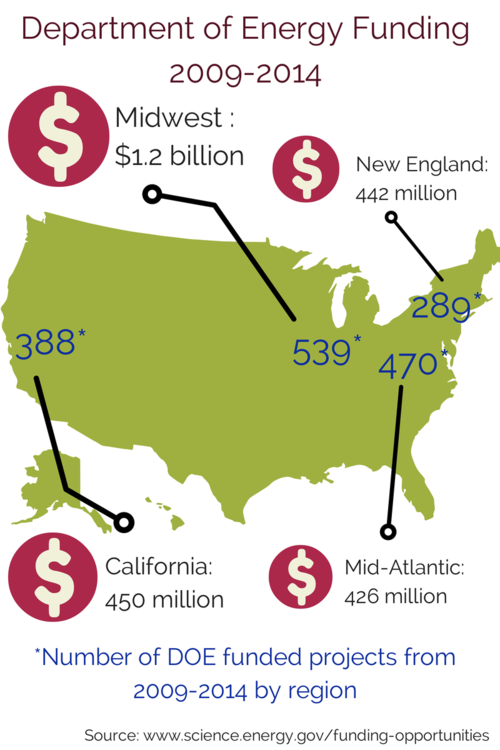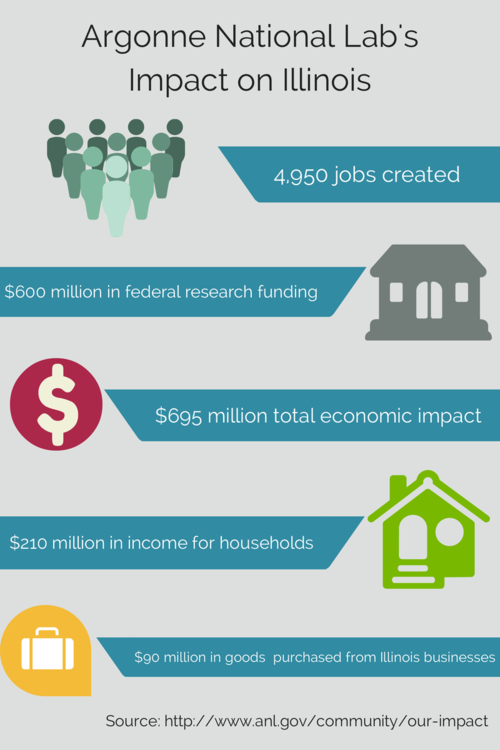The Energy Tech Revolution: Universities and Research Labs
Last month we kicked off our blog with a pretty big statement—that an energy tech revolution is underway in the Midwest. Now we’ll start to prove it, beginning with a look at the earliest stage of our innovation pipeline: universities and research labs.
There’s a lot that needs to happen before a new energy technology makes it to the consumer market, let alone before anything can be deemed “a revolution.” An idea needs to form. Research needs to be conducted. Technologies need to be tested. Innovators need mentorship. There’s a need for ideas and entrepreneurship resources, both of which are often found at a top-notch University or research lab. And the Midwest is home to some of the best.

The region’s ability to attract federal funding and the concentration of engineering talent in the Midwest are impressive, and surely contribute to successes—like the 114 Nobel Prizes affiliated with those top Universities—but that’s not the only measure of what distinguishes ours from other regions. Add to this the dozens of schools with top-ranked University programs in business, technology and entrepreneurship that have impressive track records in tech transfer and commercialization.
Energy Innovation + Entrepreneurship Resources at Universities
Northwestern has been in the entrepreneurial spotlight after students landed three consecutive wins at the Rice University Business Plan Competition (including battery materials company SiNode Systems), and the University doesn’t seem to be slowing down anytime soon. Since 2010, 45% of Northwestern MBA graduates started their own businesses, compared to just 24% between 2000 and 2009. Supporting this trend are classes such as NUvention, which help students develop and launch businesses, often through collaboration with INVO, their tech transfer office.
The University of Illinois at Urbana-Champaign, a Top 5 engineering school with 46% more engineering students than Stanford, MIT, and Caltech combined, invented the first LEDs and has helped build over 145 companies since the launch of EnterpriseWorks. This 43,000 SF incubation facility is a cornerstone of the research park with labs, offices, and common space to serve the needs of entrepreneurs. This also includes providing researchers with unique opportunities to develop, validate, and evolve technology from fundamentals into practice. For example, a partnership between electric utility Ameren Illinois and UIUC’s leading cyber security lab TCIPG (Trustworthy Cyber Infrastructure for The Power Grid) creates opportunities for researchers and entrepreneurs to commercialize technology for power grid security using Ameren’s $3M “testbed” facility.
Outsiders may say that the Midwest lacks the “startup culture” that places like Stanford University first defined. A decade ago, schools such as The University of Chicago set out to build that startup culture, adding new resources such as the Polsky Center for Entrepreneurship and The New Venture Challenge, a business plan competition that seeded what are now several big-name successes including GrubHub, Braintree and Benchprep, as well as a number of energy ventures—including SoCore Energy and Power2Switch.
While we may be biased toward Illinois’ Universities, the academics and entrepreneurship programs in Michigan, Ohio, Indiana, Wisconsin, Iowa and Minnesota are equally as rich, and with the rise of regional accelerators such as the Midwest Cleantech Open and Clean Energy Trust to further nurture these innovators – the Midwest has become a booming hub for science and energy innovation and early-stage ventures.
National Research Labs

Argonne National Lab, the largest federally funded R&D center in the Midwest with a research budget topping $700 million, is home to over 1,500 scientists and postdocs. Argonne’s discoveries over the last 65 years display a proven track record for groundbreaking research and innovation, but what’s changing is their ability to work with entrepreneurs to help fast-track commercialization.
For example, in areas of flagship research such as the $120 million Joint Center for Energy Storage Research – aka the battery hub – Argonne is exploring new ways to partner with startups and put their resources to work. Dozens of new start-up companies have grown out of Argonne research and expertise, including Akhan Technologies, one of three Argonne technologies listed in the 2013 R&D 100. Most recently, Argonne and the University of Chicago launched The Chicago Innovation Exchange, a new co-working space to drive innovation across a range of topics and apply scalable solutions for using scientific discoveries to solve difficult societal problems.
What’s next?
As a launch pad for innovative ideas, Universities and labs in the Midwest are propelling the economy forward by supporting the development of great energy businesses. The next million (or billion) dollar question remains: as great technologies become startup businesses, why is the Midwest the best place for them to grow?
For one, access to capital is surging.